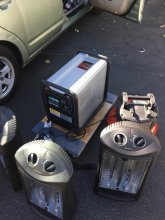Induction motors take about 5x label rating to start.
I've tested one so far (window air conditioner) and eventually plan to test central A/C, refrigerators, air compressors. After I've wired stuff together so the sensors are on line feeding house and routed to my lab.
Efficiency would be measured instantaneously, DC amps and volts in, AC amps and volts out. Same setup as no-load draw, but after load is turned on.
Basically yeah:

diysolarforum.com
(note that is in the "Humor" section)
But I would use a switch. No reason to burn contacts in the outlet.
Do NOT do this with grid power, best outcome is breakers interrupt current successfully but it can be a "use once" situation.
Worst case you discover grid can deliver more amps than breaker was designed for and very bad things happen.
So that means I would only do it to the inverter on battery power, not with grid feeding it.
But we want to stress the inverter, not just trip some 20A breaker on an outlet. Needs to hook up to a suitable plug or hard-wired.







